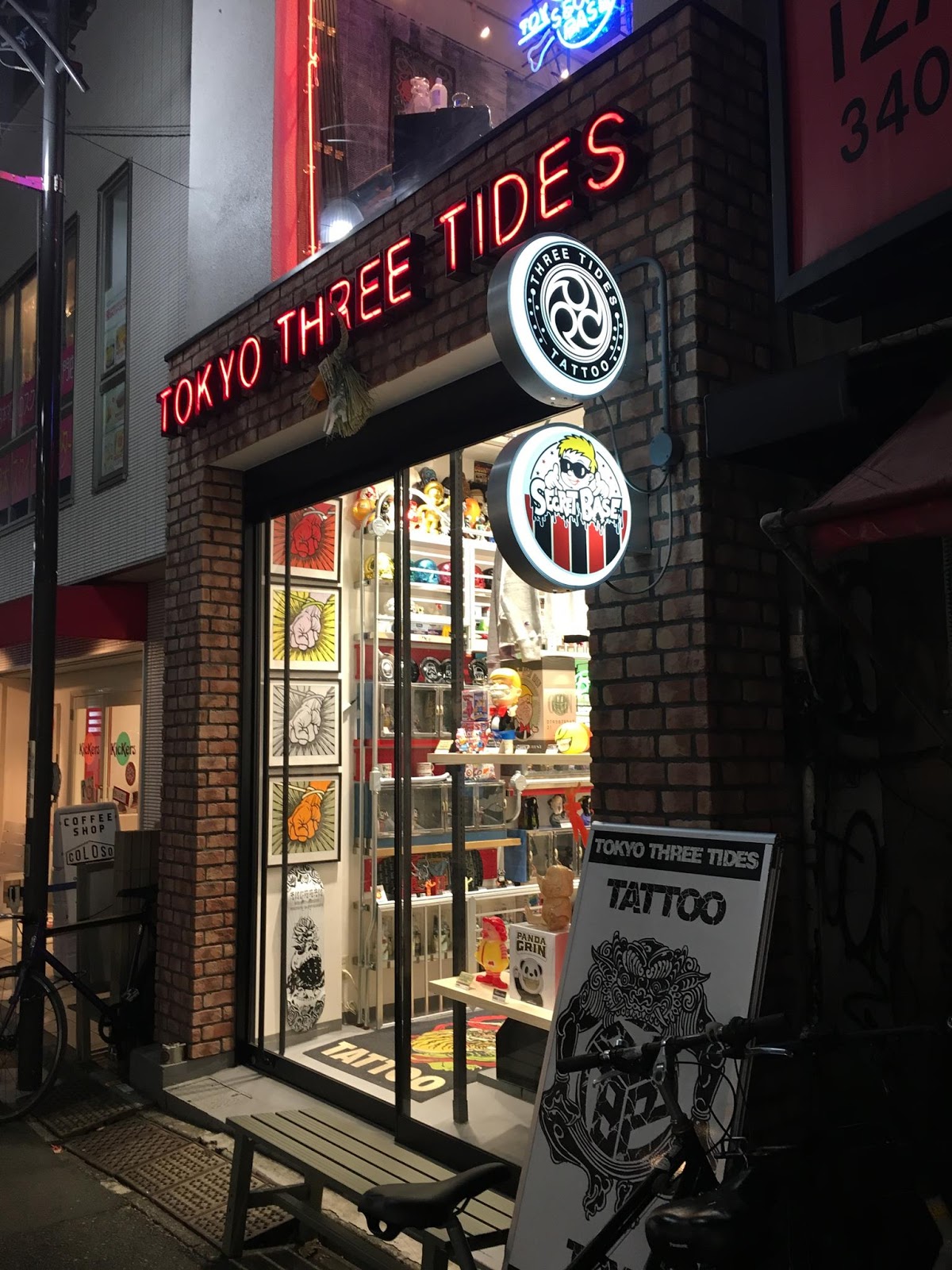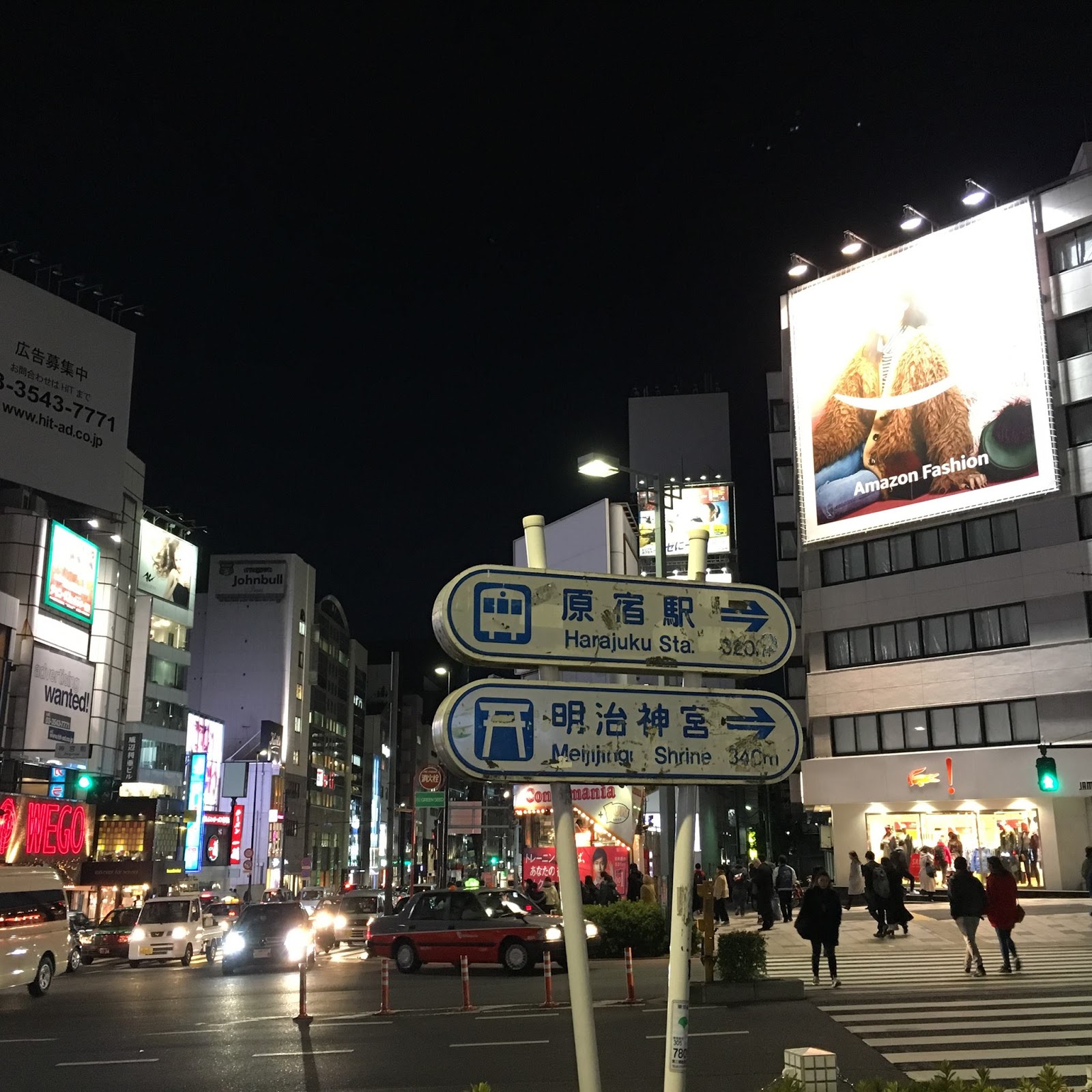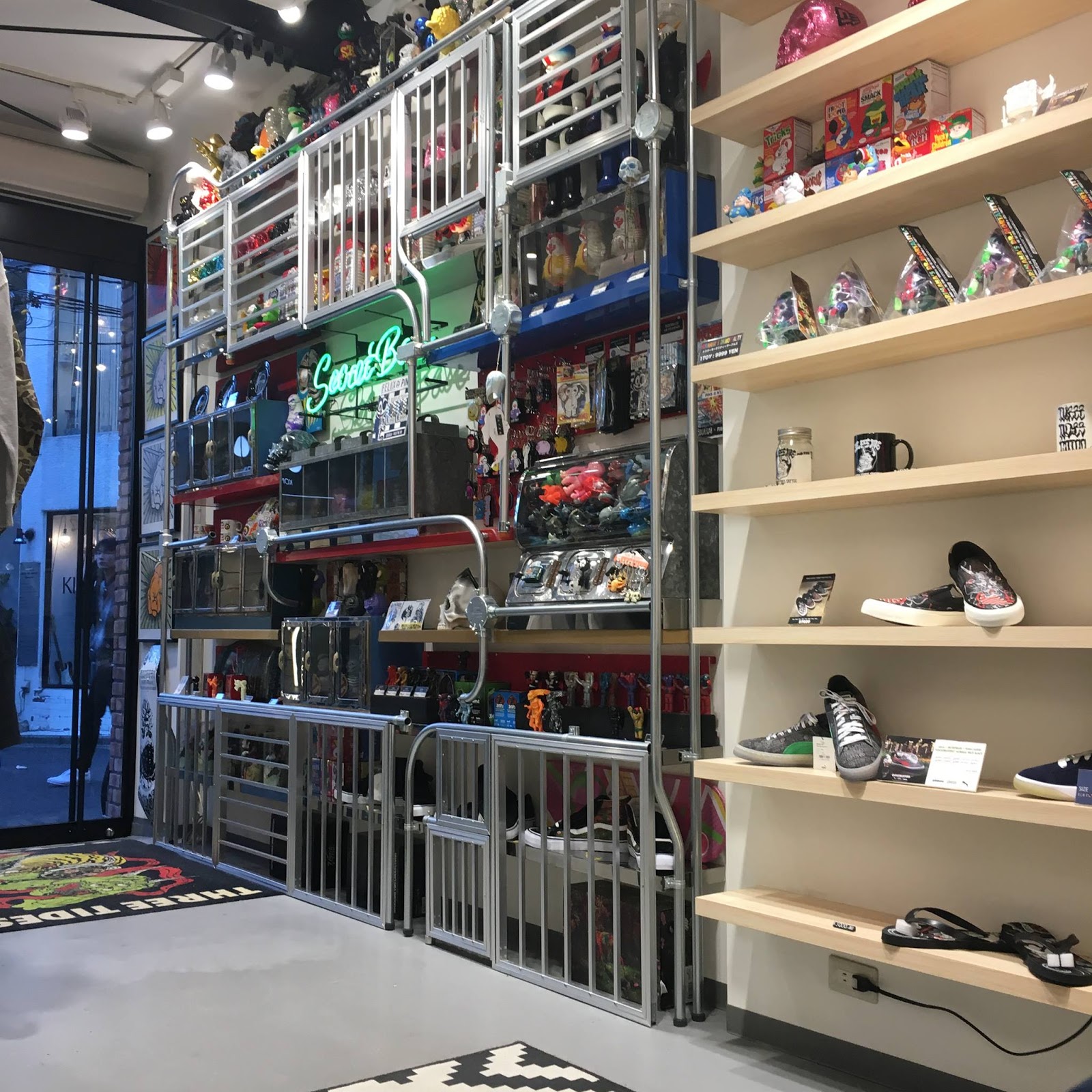Three Tides
Getting a tattoo in Japan.

Photos: Bryan Washington
Last year, I tried hitting up Three Tides Tattoo when I was in Osaka. But it just didn’t happen. I was mostly too busy getting lost. So I made a point to set a day aside in Tokyo, before I left, if I could manage to find an appointment, because the artists working at their spot by Harajuku are some of the best in the world. I’m aware that’s an impossible thing to quantify. But here I am, doing just that. Their building sits nestled just off of the main strips, and if you blink, you’ll miss the alley that leads to their street.
The studio’s success is sort of a catch-22: tattoos in Japan aren’t entirely outside of the social lexicon, but they’re mostly shunned in daily life. You’ll find most of your visible sleeves and scattered tags in the larger cities, or in their trendier (younger) pockets, like Daikanyama or Dōtonbori or Shimokitazawa. Beyond that, an exposed heart on your wrist or a phoenix or whatever is liable to prompt some whispers. For the most part, inked folks take the time to cover themselves, or dress around their art, but if you’re a foreigner with tattoos the stigma is dramatically lowered. It’s expected that you’d do that thing to your body, because it’s a little strange that you’re here anyways. You are an outsider. You clearly didn’t know better.
Japan has a very long, very nuanced history with tattoos. Much like everywhere else in the world, the reasons for getting inked have ranged from the punitive to the celebratory. Most folks who care know that there’s sometimes the implication of gang-ties[1]; but it’s simply not true that a half-sleeve immediately implicates you with the Yamaguchi-gumi. But a larger source of dismay is that they imply an attempt to stand out: Japan’s a pretty homogenous country. And you here, displaying a very private, individualized thing.
That’s chief among the reasons that most people cover up. If you’re a native, the repercussions can certainly outweigh the benefits. If you’re not willing to don some tape, you’ll have a hard time getting into some onsens. Local gyms might turn you away. The beach and public pools, sans a bodysuit, are out of the question. And the younger generation of Japanese residents are significantly more amenable to tattoos, but as the country (and the world) turns further and further away from the West as a leading cultural influence, it remains to be seen whether tradition will hold out, or whether new traditions, and new influences, will bleed through—to say nothing of just how much foreigners will be privy to those developments.
But it’s still sort of a wonder that Three Tides has the reputation that it does. The company began with Mutsuo, its owner and founder. He started tattooing back in the early aughts, around 2001, and quickly became adept at working in both Japanese and American styles. His shop was one of the first “Western-style” parlors in Japan: you could just walk in and ask for something, a panther or a skateboard or the sun. Most studios didn’t do that. Or at least not in such a high-frequency. And now his parlors, and the folks who work for him, are acknowledged as some of the most proficient in the world. Both locations have reported a sizable chunk of clientele, from all over the globe, and their artists’ respective social media accounts are stacked with folks whose names, for whatever reason, we all know. And the thing is, they look beautiful. If a good tattoo brings a piece of art to your body, a great one makes your body a piece of art. So that’s what Three Tides does: you walk in as you, and you walk out as art.
After tossing up the idea of a weekend in Osaka, I ended up deciding to try the Tokyo location. I’ve already got a few tattoos, with a bucket list for a few more. But the main thing I was looking to get was a koi fish. When I was a kid, this restaurant around the corner from our place kept a big-ass tank by the entrance. We were always ordering take-out, so it had my fingerprints all over it. But the lady who owned the place never swatted me away. Sometimes she’d put her hands up there with me. And then, a few summers back, after getting quizzed by customs at the airport on all of the drugs in their little book, I saw this dude across the terminal with the most beautiful one wrapped around his elbow.
So I hit them up. A few hours later, I got an email in Yoyogi Park saying that yes, an artist could take me, if I made a deposit and showed up on time. I wanted Ganji to do it, because he looked like the man, and also I’d seen that he’d tattooed black people before. I sent them the image I wanted, two koi, one swimming upstream, the other downstream, and lamented the fact that getting tagged again meant I’d probably be rocking a jacket for the rest of the trip.

The day of my appointment, I showed up fifteen minutes late. The local line I’d needed was delayed. I stood on the platform, dreading losing the deposit. And of course once I’d made it to Harajuku I found a new way to get lost. When I finally stepped through the door, a guy behind the counter looked up at me, and then away, before a lady sitting beside him asked if I was who I am, in English. She said Ganji would be downstairs shortly. Then she smiled.
When Ganji made it downstairs, he looked at me (a little annoyed, maybe) and shook my hand. I have no qualms in saying that he is easily one of the coolest human beings I have met in this life. He and the lady from the desk conferred in Japanese, and they asked about the image I wanted. He asked where I wanted it, and how much color (for the obvious reason). But then he squinted a little further, and turned back to the image.
He started speaking to the woman in a lilting Japanese. He’d point to one part of a koi, and then another. He’d point at my arm. He’d ask if she agreed. Then he turned to me and said, I can do this, but it’s not a koi. He pointed at the image again, and said, Koi don’t have this many fins.
This is not Japanese, he said. It won’t look good. But I can still do it.
Of course I told him that he was the man, to do what he recommended. Then, almost at once, the tension whooshed right out of the room. Ganji and the lady smiled, and he showed me what he thought made sense, and I agreed, because it was lovely, and he threw my little-printout in the trash. I told the lady I was sorry about the hassle, and she told me it wasn’t my fault.
You have Ganji to advise you, she said. You took his advice. That was smart.

Afterwards, he brought me upstairs and inked me. With the state of tattooing being tenuous in Japan, I didn’t fill out any consent forms or anything like that. And it bothered me for a half-second, but then it didn’t anymore: all things considered, nowadays, this wouldn’t be the worst way to go.
A pair of British kids sat across from me, and they couldn’t have been too far from their teens. They counted out yen on the counter in front of them. Once Ganji started shading, this song started playing above us[2]. From time to time, another tattooist wandered over to check out what he was doing, and he’d explain, to the tune of Sakamoto, gesturing with one hand and working with the other. Before he started layering, another artist caught my eye. She told me it looked really great, pointing towards the mirror.
And it did. It really did. The lady downstairs smiled when she saw it, too. She’d wandered upstairs sometime in the middle of the session. She said, Less is more, and the tattooist beside her asked what that meant in Japanese. After a quick explanation, she nodded.
Less is more, she agreed.
Afterwards, when it came time to pay, the always awkward business of tipping in Japan reared its head (you don’t do it, but tattoos have some flexibility). Everyone looked a little flummoxed when I flipped through my wallet. But he accepted it, nonetheless. We called it a gift. And then he gave me a gift[3]: a pair of socks he’d designed himself. We all thanked each other. We bowed a little a bit. It was cold when I left, but I felt brand-new, brand-new. But before I made it back down the alley, I hadn’t slipped on my jacket, and some kids around the Bathing Ape saw my arm in a flash before.
I don’t know what I expected. They hit me a with a high-five, and a quick Sugoi[4]. Then they disappeared through an alley, laughing all the way down.
[1] This is a pretty good documentary, even if the dubbing is absolutely preposterous.
[2] There’s a lot to be said about the preferred soundtrack of your tattooist: the first artist I frequented, a white guy from the mid-west, only ever played Beats, Rhymes, and Life on repeat. When he moved back to Minnesota, my next guy — a Latino dude from Austin — worked to tracks soaked in reverb. All of this is to say that I didn’t ever expect to find myself crying, to the tune of Sakamoto, in a tattoo parlor in Shinjuku. But what can you do.
[3] Which I’m aware that I probably “paid” for, but still.
[4] “Awesome” is a close English equivalent.
